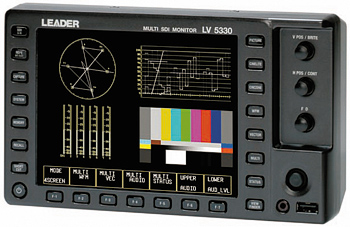Leader LV5330 Wins Filmmaker's Approval
LOS ANGELES
I've worked with various Leader products over the years and have always found their equipment very intuitive and easy to use. These were just two of the reasons that I selected their new LV5330 instrument as a replacement for my on-camera monitor.
Another reason I selected the LV5330 was its Cinelite and Cinezone software. Leader developed these tools to help bridge the gap between film and digital video, and to help display measurements in a more visual manner. One doesn't always have the luxury of a tented video village, or even the 10 seconds it would take to analyze the readings on a traditional waveform display. These very useful tools provide immediate visual feedback on the health of your video signal.

The Leader L5330 video monitor Cinezone transforms your video image into a display similar to thermal imaging. It works like a two-dimensional histogram, displaying a progression of colors that define various luminance levels in your image. You can also manually adjust the upper and lower limits to indicate if you're clipping highlight information or crushing shadow detail. Cinezone is a quick spot-checking tool for locating hot spots, and is very handy for green/blue screen work, as it immediately reveals unevenly lit areas.
f-STOP READINGS
Cinelite provides pixel specific measurements in luminance or RGB percentage. You can set up to three measuring points on-screen, and choose if you want pinpoint accuracy, or just an average of values over a small area. One of the greatest features is that after the camera has processed the image, I can work in f-stops instead of percentages or IRE units. Coming from a film background, I'm accustomed to knowing how many stops of latitude I have within a particular film stock, and I tailor lighting ratios based on this information. With digital video cameras, the "sweet spot" tends to be even smaller, and being able to read it precisely is a huge benefit.
PROVIDES HD PICTURE MONITORING TOO
By far, my greatest reason for purchasing the LV5330 is that it allows me to combine the test equipment that I need with a compact on-board picture monitor. I've always made use of small onboard monitors, especially when shooting in HD. Those usually have screen resolutions of 800x480, and some come with very coarse waveform displays. For the same weight and size, I now have a very high-resolution display (1024x768 pixels) for evaluating pictures, along with a whole set of professional test tools. I traded in my "dumb" monitor for a "smart" one. While I probably won't be using all the bells and whistles that come standard with the unit, one function I will be using continuously is the screen capture feature. It allows you to take snapshots of not only your current picture display (for continuity or re-creation) but also of all of the associated exposure data that goes along with it. This information can be saved to a USB thumbdrive, which could prove invaluable for pick-ups or re-shoots.
Your eyes can adapt to all kinds of color washes and make them read as neutral, and an 18-hour day can affect your judgment of brightness and contrast; however, scopes don't lie. They are consistent and completely objective observers of your video signal. I know that I plan to bring my LV5330 on every job that comes along.
Suny Behar is a freelance director and cinematographer who has shot numerous short narrative films, feature films and music videos during the past 12 years. He may be contacted at sunybehar@aol.com.
For additional information, contact Leader at 800-645-5104 or visitwww.leaderusa.com.
The professional video industry's #1 source for news, trends and product and tech information. Sign up below.
